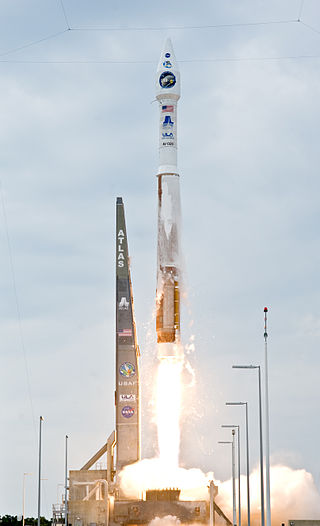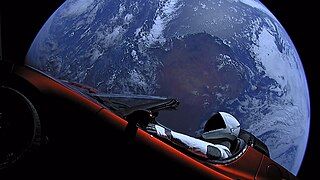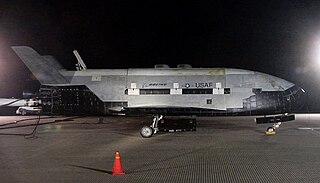
Cape Canaveral Space Force Station (CCSFS) is an installation of the United States Space Force's Space Launch Delta 45, located on Cape Canaveral in Brevard County, Florida.

A spaceplane is a vehicle that can fly and glide like an aircraft in Earth's atmosphere and maneuver like a spacecraft in outer space. To do so, spaceplanes must incorporate features of both aircraft and spacecraft. Orbital spaceplanes tend to be more similar to conventional spacecraft, while sub-orbital spaceplanes tend to be more similar to fixed-wing aircraft. All spaceplanes to date have been rocket-powered for takeoff and climb, but have then landed as unpowered gliders.

The Boeing X-37, also known as the Orbital Test Vehicle (OTV), is a reusable robotic spacecraft. It is boosted into space by a launch vehicle, then re-enters Earth's atmosphere and lands as a spaceplane. The X-37 is operated by the Department of the Air Force Rapid Capabilities Office, in collaboration with United States Space Force, for orbital spaceflight missions intended to demonstrate reusable space technologies. It is a 120-percent-scaled derivative of the earlier Boeing X-40. The X-37 began as a NASA project in 1999, before being transferred to the United States Department of Defense in 2004. Until 2019, the program was managed by Air Force Space Command.

Atlas V is an expendable launch system and the fifth major version in the Atlas launch vehicle family. It was originally designed by Lockheed Martin, now being operated by United Launch Alliance (ULA), a joint venture between Lockheed Martin and Boeing. It is used for DoD, NASA, and Commercial payloads. It is America's longest-serving active rocket. After 87 launches, in August 2021 ULA announced that Atlas V would be retired, and all 29 remaining launches had been sold. As of 6 October 2023, 17 launches remain.

FalconSAT is the United States Air Force Academy's (USAFA) small satellite engineering program. Satellites are designed, built, tested, and operated by Academy cadets. The project is administered by the USAFA Space Systems Research Center under the direction of the Department of Astronautics. Most of the cadets who work on the project are pursuing a bachelor of science degree in astronautical engineering, although students from other disciplines join the project.
The Space Test Program (STP) is the primary provider of spaceflight for the United States Department of Defense (DoD) space science and technology community. STP is managed by a group within the Advanced Systems and Development Directorate, a directorate of the Space and Missile Systems Center of the United States Space Force. STP provides spaceflight via the International Space Station (ISS), piggybacks, secondary payloads and dedicated launch services.

Minotaur IV, also known as Peacekeeper SLV and OSP-2 PK is an active expendable launch system derived from the LGM-118 Peacekeeper ICBM. It is operated by Northrop Grumman Innovation Systems, and made its maiden flight on 22 April 2010, carrying the HTV-2a Hypersonic Test Vehicle. The first orbital launch occurred on 26 September 2010 with the SBSS satellite for the United States Air Force.

USA-212 was the first flight of the Boeing X-37B Orbital Test Vehicle 1, an American robotic vertical-takeoff, horizontal-landing (VTHL) spaceplane. It was launched aboard an Atlas V rocket from Cape Canaveral on 22 April 2010, and operated in low Earth orbit. Its designation is part of the USA series.

LightSail is a project to demonstrate controlled solar sailing within low Earth orbit using a CubeSat. The project was developed by The Planetary Society, a global non-profit organization devoted to space exploration. It consists of two spacecraft — LightSail 1 and LightSail 2. LightSail 1 was an engineering demonstration mission designed to test its new sail deployment method in space, it did not perform solar sailing. LightSail 2 was a fully functional spacecraft intended to demonstrate true solar sailing and incorporated the lessons learned from LightSail 1. LightSail is a follow-on project to Cosmos 1 — a solar-sail spacecraft designed by The Planetary Society in the early 2000s, which was destroyed during a launch failure in 2005.

USA-226 was the first flight of the second Boeing X-37B, the Orbital Test Vehicle 2, an American unmanned robotic vertical-takeoff, horizontal-landing spaceplane. It was launched aboard an Atlas V rocket from Cape Canaveral on 5 March 2011, and landed at Vandenberg Air Force Base on 16 June 2012. It operated in low Earth orbit. Its mission designation is part of the USA series.

Falcon Heavy is a partially reusable super heavy-lift launch vehicle that can carry cargo into Earth orbit, and beyond. It is designed, manufactured and launched by American aerospace company SpaceX.

This article documents notable spaceflight events during the year 2018. For the first time since 1990, more than 100 orbital launches were performed globally.
Technology Education Satellite (TechEdSat) is a successful nano-sat flight series conducted from the NASA Ames Research Center in collaboration with numerous universities. While one of the principal aims has been to introduce young professionals and university students to the practical realm of developing space flight hardware, considerable innovations have been introduced. In addition, this evolving flight platform has tested concepts for Low Earth Orbit (LEO) sample return, as well as planetary nano-sat class mission concepts.

USA-240, also referred to as Orbital Test Vehicle 3 (OTV-3), is the second flight of the first Boeing X-37B, an American unmanned robotic vertical-takeoff, horizontal-landing spaceplane. It was launched to low Earth orbit aboard an Atlas V rocket from Cape Canaveral on 11 December 2012. Its mission designation is part of the USA series.
SHERPA is a commercial satellite dispenser developed by Andrews Space, a subsidiary of Spaceflight Industries, and was unveiled in 2012. The maiden flight was on 3 December 2018 on a Falcon 9 Block 5 rocket, and it consisted of two separate unpropelled variants of the dispenser.

USA-261, also referred to as Orbital Test Vehicle 4 (OTV-4) or AFSPC-5, is the second flight of the second Boeing X-37B, an American unmanned vertical-takeoff, horizontal-landing spaceplane. It was launched to low Earth orbit aboard an Atlas V rocket from Cape Canaveral on May 20, 2015. Its mission designation is part of the USA series.

USA-277, also referred to as Orbital Test Vehicle 5 (OTV-5), is the third flight of the second Boeing X-37B, an American unmanned vertical-takeoff, horizontal-landing spaceplane. It was launched to low Earth orbit aboard a Falcon 9 rocket from LC-39A on September 7, 2017. Its mission designation is part of the USA series.
D-Orbit is a private aerospace company headquartered in Italy with subsidiaries in Portugal, the UK and the US.

United States Space Force-52 (USSF-52), also referred to as Orbital Test Vehicle 7 (OTV-7), will be the fourth flight of the second Boeing X-37B, an American unmanned vertical-takeoff, horizontal-landing spaceplane. It will be launched to low Earth orbit aboard a Falcon Heavy rocket from LC-39A December 2023.















